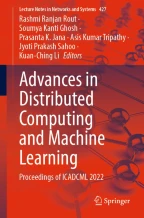Automated Resume Classification Using Machine Learning

One of the current job recruiter’s biggest challenges is to filter the right candidate’s resume over the pool of resumes. For a single job post, many times more than thousands of applicants send their resumes. However, many of them are not suitable for the offered job. Manually filtering the right candidate’s resume is not feasible from the pool; hence, an automated system may help pick the selective candidate’s resume by applying natural language processing. This research suggested a machine learning-based automated resume classification model which classifies the resume into different categories based on their content. The experiment is done with the dataset consisting of ten categories of resumes. The outcomes of the proposed model achieve satisfactory classification reports in terms of precision, recall and F1-score with bi-gram model.
This is a preview of subscription content, log in via an institution to check access.
Access this chapter
Subscribe and save
Springer+ Basic
€32.70 /Month
- Get 10 units per month
- Download Article/Chapter or eBook
- 1 Unit = 1 Article or 1 Chapter
- Cancel anytime
Buy Now
Price includes VAT (France)
eBook EUR 117.69 Price includes VAT (France)
Softcover Book EUR 158.24 Price includes VAT (France)
Tax calculation will be finalised at checkout
Purchases are for personal use only
Similar content being viewed by others

N-Gram Feature Based Resume Classification Using Machine Learning
Chapter © 2022

A Hybrid Approach to Conceptual Classification and Ranking of Resumes and Their Corresponding Job Posts
Chapter © 2018

Resume Screening Using Machine Learning
Chapter © 2022
References
- Amin S, Jayakar N, Sunny S, Babu P, Kiruthika M, Gurjar A (2019) Web application for screening resume. In: 2019 international conference on nascent technologies in engineering (ICNTE). IEEE, pp 1–7 Google Scholar
- Bhatt B, Premal JP, Gaudani H (2014) A review paper on machine learning based recommendation system. IJEDR 2(4):3955–3961 Google Scholar
- Chen J, Zhang C, Niu Z (2018) A two-step resume information extraction algorithm. Math Probl Eng Google Scholar
- Färber F, Weitzel T, Keim T (2003) An automated recommendation approach to selection in personnel recruitment, pp 2329–2339 Google Scholar
- Guo X, Jerbi H, O’Mahony MP (2014) An analysis framework for content-based job recommendation. In: 22nd international conference on case-based reasoning (ICCBR). Cork, Ireland, 29 Sept–01 Oct 2014, pp 1–10 Google Scholar
- Lofink CR (2021) Resume analysis: a comparison of two methods. JBET 3:81 Google Scholar
- Malinowski J, Keim T, Wendt O, Weitzel T (2006) Matching people and jobs: a bilateral recommendation approach. In: Proceedings of the 39th annual Hawaii international conference on system sciences (HICSS’06), vol 6. IEEE, pp 1–9 Google Scholar
- Mohamed A, Bagawathinathan W, Iqbal U, Shamrath S, Jayakody A (2018) Smart talents recruiter-resume ranking and recommendation system. In: 2018 IEEE international conference on information and automation for sustainability (ICIAfS). IEEE, pp 1–5 Google Scholar
- Qin C, Zhu H, Xu T, Zhu C, Jiang L, Chen E, Xiong H (2018) Enhancing person-job fit for talent recruitment: an ability-aware neural network approach. In: The 41st international ACM SIGIR conference on research and development in information retrieval, pp 25–34 Google Scholar
- Roy PK, Chowdhary SS, Bhatia R (2020) A machine learning approach for automation of resume recommendation system. Proc Comput Sci 167:2318–2327 ArticleGoogle Scholar
- Roy PK, Tripathy AK, Das TK, Gao XZ (2020) A framework for hate speech detection using deep convolutional neural network. IEEE Access 8:204951–204962 ArticleGoogle Scholar
- Shalaby W, AlAila B, Korayem M, Pournajaf L, AlJadda K, Quinn S, Zadrozny W (2017) Help me find a job: A graph-based approach for job recommendation at scale. In: 2017 IEEE international conference on big data (big data). IEEE, pp 1544–1553 Google Scholar
- Sipior JC, Lombardi DR, Gabryelczyk R (2021) Ai recruiting tools at shipit2me.com. Commun Assoc Inf Syst 48(1):39 Google Scholar
- Sivaramakrishnan N, Subramaniyaswamy V, Arunkumar S, Soundaryarathna P (2018) Validating effective resume based on employer’s interest with recommendation system. Int J Pure Appl Math 119(12):13261–13272 Google Scholar
- Trappey AJ, Trappey CV, Wu CY, Fan CY, Lin YL (2012) Intelligent recommendation methodology and system for patent search. In: Proceedings of the 2012 IEEE 16th international conference on computer supported cooperative work in design (CSCWD). IEEE, pp 172–178 Google Scholar
- Tripathi D, Edla DR, Cheruku R, Kuppili V (2019) A novel hybrid credit scoring model based on ensemble feature selection and multilayer ensemble classification. Comput Intell 35(2):371–394 ArticleMathSciNetGoogle Scholar
- Tripathi D, Edla DR, Kuppili V, Bablani A (2020) Evolutionary extreme learning machine with novel activation function for credit scoring. Eng Appl Artif Intell 96:103980 Google Scholar
- Xu B, Zhang B (2020) Research on the construction of information platform of employment and entrepreneurship for college. In: 2020 international conference on big data, artificial intelligence and Internet of things engineering (ICBAIE), pp 142–145. https://doi.org/10.1109/ICBAIE49996.2020.00036
- Yang S, Korayem M, AlJadda K, Grainger T, Natarajan S (2017) Combining content-based and collaborative filtering for job recommendation system: a cost-sensitive statistical relational learning approach. Knowl Based Syst 136:37–45 ArticleGoogle Scholar
Author information
Authors and Affiliations
- Department of Computer Science and Engineering, Indian Institute of Information Technology, Surat, India Pradeep Kumar Roy
- School of Computer Science and Engineering, VIT-AP University, Vijayawada, Andhra Pradesh, India Sunil Kumar Singh
- School of Information Technology and Engineering, Vellore Institute of Technology, Vellore, India Tapan Kumar Das & Asis Kumar Tripathy
- Pradeep Kumar Roy

